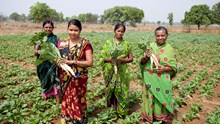
Global commodity prices are forecasted to drop significantly in the coming years, with a 12% fall anticipated in 2025 and a further 5% decline in 2026, according to the World Bank’s latest Commodity Markets Outlook. If realized, prices would hit their lowest levels of the decade, driven by weakening economic growth and a surplus in oil supply.
Although nominal prices will remain above pre-pandemic levels, inflation-adjusted prices are expected to fall below the 2015–2019 average—signaling the end of the price boom sparked by the global recovery from COVID-19 and the 2022 Ukraine conflict.
Inflation Risks May Ease Amid Trade Tensions
The price downturn is expected to offset some of the inflationary pressures caused by escalating trade barriers between major economies. For instance, the energy price surge in 2022 added over 2 percentage points to global inflation, but this trend reversed in 2023 and 2024. Energy prices are projected to fall by 17% this year and another 6% in 2026, potentially cushioning the inflationary effects of higher tariffs.
Oil and Coal Demand Expected to Dip Further
Brent crude oil is predicted to average USD 64 a barrel in 2025 and USD 60 in 2026—down from USD 81 in 2024. This decline is partly due to reduced global demand and increased adoption of electric vehicles, especially in China, where 40% of new car sales last year were electric or hybrid models.
Coal prices are also set for a steep fall, declining by 27% in 2025 and another 5% in 2026, as growth in coal consumption slows, particularly in developing nations.
Food Prices to Decline, But Hunger Crisis Persists
Global food commodity prices are expected to decrease by 7% in 2025 and a further 1% in 2026. Despite this, acute food insecurity is worsening in conflict-affected areas, with the United Nations estimating 170 million people in 22 countries will face severe hunger this year. Falling food prices could support humanitarian relief efforts but will not resolve conflict-driven food insecurity.
Mixed Trends Across Other Key Commodities
Gold prices are forecasted to reach record highs in 2024 before stabilizing, maintaining a value around 150% higher than pre-pandemic levels due to continued geopolitical uncertainty. In contrast, industrial metal prices are expected to drop, impacted by ongoing trade tensions and weak real estate activity in China.
Apart from this, the World Bank also highlights an era of intense commodity-price swings. The volatility observed in the 2020s—marked by rapid crashes and spikes due to events like COVID-19 and the Ukraine war—has shortened the usual four-year commodity cycle to just two years.
Commodity prices have whipsawed throughout the 2020s. This could become the new normal, and navigating such turbulence will require developing economies to bolster fiscal stability, institutional strength, and investment environments.

Weak economic growth and ample oil supply are expected to push global commodity prices to their lowest levels of the 2020s. The decline could ease inflation but slow growth in 2/3rds of developing economies.
— World Bank (@WorldBank) April 29, 2025
Read the #CMO2025 for more details ➡️https://t.co/pEhRrt7FLA pic.twitter.com/vOJFcfzudV
Indermit Gill, Chief Economist at the World Bank Group, emphasized that the combination of low prices and high volatility could threaten long-term progress in two-thirds of developing economies, which rely heavily on commodity exports. To counter these risks, he advised countries to:
-
Restore fiscal discipline,
-
Improve the business environment to attract private capital, and
-
Pursue trade liberalization wherever possible.
These measures are seen as essential for developing economies to weather future commodity market disruptions and build more sustainable economic foundations.
(Inputs taken from- World Bank’s Commodity Markets Outlook)
















